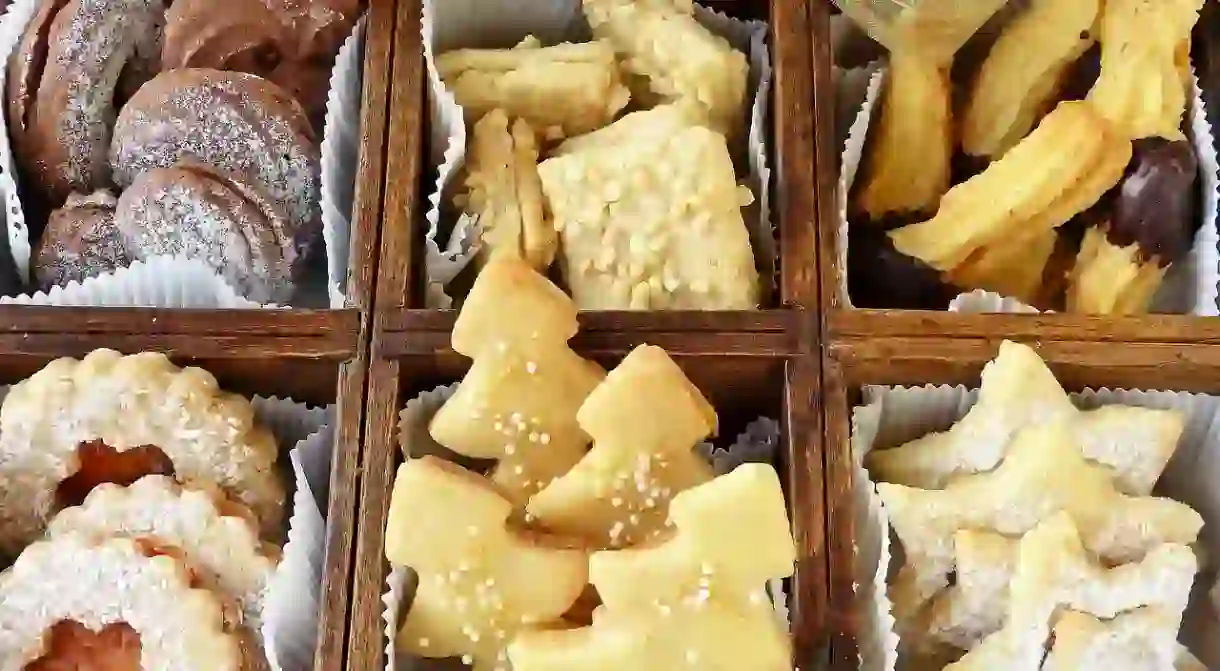9 Different German Cookies You Need to Try on Your Next Trip

Christmas in Germany is a time for mulled wine, fairy lights, dreamy markets and sugary treats, with recipes for popular Christmas cookies passed down from one generation to the next. Whether from bakeries, Christmas markets, or made at home, here are nine typical Christmas cookies you have to try this season.
Zimtsterne
These cinnamon stars are an all-time favourite and a staple snack in German households during the Christmas season. All you need is egg whites, powdered sugar, almonds, and most importantly cinnamon for the dough, as well as star-shaped cookie cutters. After a few minutes in the oven and sufficient time to cool off, the cookies are topped with icing and if you want, decorated with cranberries or walnuts.

Spritzgebäck
Spritz biscuits come in all shapes and forms. In the winter time, German grannies and cooks up and down the land get to work mixing flour, sugar, eggs, butter and vanilla sugar and kneading the dough until it’s a smooth, solid mass before getting out their meat mincer and pressing the cookies into shape, mostly long sticks, circles or s-forms. If you don’t have a mincer you can get creative with cookie cutters instead.

Vanillekipferl
The ingredients used for these vanilla crescents vary slightly depending on each family’s recipe, but generally include flour, sugar, butter, vanilla sugar and nuts. Ground almonds and hazelnuts are most commonly used, but peanuts work as well. Fresh bourbon vanilla adds some extra flavour. The dough is moulded into small crescents and after baking, coated in powdered sugar.

Kokosmakronen
These coconut macaroons are quickly made – all that’s needed is beaten egg whites carefully mixed with sugar, and coconut flakes. If you don’t want to waste the egg yolks, consider making Engelsaugen (see below) as well. The mounds are placed on round wafer papers and baked in the oven. The juicy coconut macaroons can be left as they are, or coated with melted chocolate.

Schwarz-Weiß Gebäck
You can get super creative with this recipe. The secret lies in preparing the dough with flour, powdered sugar, butter, vanilla sugar and a bit of salt, then taking half of it and adding some cocoa powder (some recipes call for a bit of rum as well). Now it’s up to you to blend the two to create shapes and patterns, such as chequered squared or black-and-white roulades.

Engelsaugen
Put flour, sugar, egg yolks, baking powder, butter, vanilla sugar and a pinch of salt in a blender and mix the dough until it’s smooth. Form little balls and put them in the fridge for a couple of hours. Once the mixture has hardened, press a hole in the middle of each ball and fill each hole with red currant or raspberry jelly. Ten to 15 minutes in the oven, et voilà – the angels’ eyes are done.

Spekulatius
This short pastry recipe is particularly popular in western Germany as well as Belgium and the Netherlands. A specific mix of Christmassy spices makes Spekulatius a favourite of the season. Cloves, cardamom and cinnamon are mixed into the dough of brown sugar, eggs, flour, baking soda and ground almonds and pressed into biscuits moulds with Christmas motifs.

Bethmännchen
Bethmännchen is a Frankfurt speciality. Raw marzipan is mixed with egg whites, ground almonds and powdered sugar, sometimes refined with orange-based liqueur or rose water. The dough is formed into balls, decorated with blanched and halved almonds and dabbed with a mix of egg yolks and milk before being placed in the oven.

Florentiner
In southern Germany, Florentiner are essential to the Advent season, though the recipe is thought to have originated in France. Sugar, honey, butter and cream are heated in a pot before thinly sliced almonds, and sunflower seeds are added. It’s important to stir the blend continuously for a few minutes, then pour the mass onto a baking sheet or in moulds and bake it for 10 minutes. After that, the underside is coated with dark chocolate.














